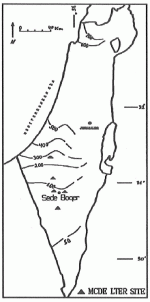The Ecology of Global Climate Change in a Desert/Non-Desert Ecotone
Ecologically speaking, the State of Israel is an ecotone: it is a narrow 520 kin-long strip of land, with a mean annual precipitation range from 30 mm in the south to 700 mm in the north, i.e., a mean rate of change of 16mm per 10 km across the ecotone. The rate is 25 mm per 10 km in an 80-km belt in the center of Israel, where the desert meets the non-desert: the transition zone.
Long-term research of global climate change (GCC) ecology within this zone has three merits:
- The steep gradient generates spatial and temporal patchiness and instability. It is anticipated that the biota there is highly adaptable; hence, it should react clearly and fast to experimental manipulations simulating climate change
- Since climatic changes should be most apparent there, the transition zone can serve as a sensitive arena for detecting ecological responses to climate changes elsewhere, and for monitoring the resulting fluctuations in populations’ distributional boundaries
- Due to their anticipated adaptability, species of the transition zone may constitute biogenetic and ecological resources for rehabilitation of regions damaged by GCC effects. The transition zone may function as a refuge, which should be properly managed in order to be conserved. Prone to desertification exacerbated by GCC, Israel provides an opportunity to explore active measures of arresting the desertification of desert/non- desert transition zones.
Mitrani Center for Desert Ecology
The Mitrani Center for Desert Ecology (MCDE) of the Blaustein Institute for Desert Research, located within this transition zone, has recently launched a program with the following goals:
- To predict the reactions of populations, communities and ecosystems to GCC
- To verify the predictions, by developing a long-term ecological monitoring scheme
- To investigate means for utilizing biogenetic resources of climatic transition zones for ecosystem restoration and rehabilitation.
The five long-term ecological research sites established by the MCDE cover the variation within the ecotone in rainfall (75, 100, 150, 200 mm) and in habitat (bess plain, rocky watershed, sand dune).
Scientists from several research institutes and universities in the United States, Canada, Russia and Israel, are collaborating on projects initiated in 1991:
- Stability of the rock/endolithic-lichen/snail ecosystem under increased rainfall and two alternative scenarios of increased and decreased dew
- Life history traits of algae- eating snails subjected to increased precipitation; responses of dune annual plant communities to elevated and reduced soil moisture\
- Effect of reduced habitat structure, due to predicted thinning of perennial plants, on spider community structure
- Application of patch- dynamics ecology for exploring a novel land management practice “savannization,” which couples landscape modification with afforestation as an anti-desertification measure
- Effect of changes in precipitation and temperature on decomposition of litter through their effect on soil microorganisms and microarthropods; and feasibility of using desert Tenebrionid beetles as indicators of GCC.
The MCDE research sites are open for collaborative research. For details: U. Safriel, MCDE, the Blaustein Institute for Desert Research, Sede Boqer 84990, Israel.

 Enlarge this image
Enlarge this image